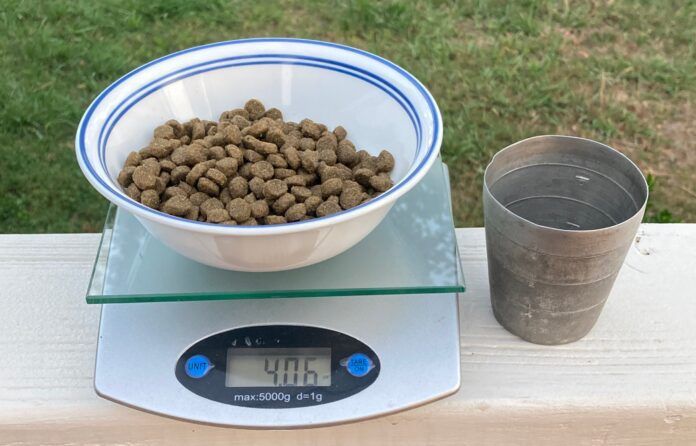
Ask any owner who feeds kibble to their dog how much they feed to their dog, and you will invariably get the amount expressed in cups: half a cup, one cup, three cups, etc.
When you’re asking someone who has an overweight dog, the question should be more pointed than that: What do you to measure that food? What sort of cup are you using to scoop that food? Veterinarians joke about the “cup” being a 42-ounce Big Culp cup, repurposed from a trip to 7-11, but it’s actually no laughing matter, because the number of calories represented in “1 cup” of various designs varies widely – and this can contribute to a dog’s failure to lose weight. Which of course contributes to every other sort of health problem a dog can have, especially difficulty with mobility as a senior.
Just for fun, I grabbed a few cups from my cupboard, scooped up a “cup” of the kibble I am currently feeding my oldest and youngest dogs. I took a casual scoop; I didn’t shake the food or scrupulously eyeball the how level the amount of food was in each. I then weighed the amount of food in each.

Most of us are aware that most coffee cups in our cupboards contain far more than an actual “cup” of liquid; coffee enthusiasts may drink from mugs that contain two actual “cups” of coffee. The amount of food in each “cup” varied a lot (although I somehow managed to get the exact same amount in each of the two one-cup measuring cups I used).
- White cup 6.46 oz
- Tahoe cup: 8.04 oz
- Aluminum measuring cup: 4.06
- 1 cup measuring cup: 4.06
- 2 cup measuring cup: 4.97
Even with what I guessed was the most accurate tool for measuring accurately, the aluminum measuring cup that has no potential “extra” room at the top (like the glass measuring cup does), it’s possible to scoop with a certain amount of variation.
- aluminum measuring cup filled level 4.06
- aluminum measuring cup, heaping 4.66
Kibble size and shape matters, too! It also makes a difference whether you shake or tap the cup after scooping, making all the kibbles shift in order to compact themselves more tightly.
For all of these reasons, a cup is really a terrible way to measure how much we feed our dogs and how we express that amount to our veterinarians, who not only have to interpret what we might mean when we say “cup” but also have no idea of the calorie content of the food we are feeding.
I looked at the calorie content of just a random few foods from WDJ’s searchable dry dog food database and found quite a variety of calories found in regular dog foods (I didn’t look at any of the Weight control” or “lite” foods), from 340 kcals/cup in Solid Gold’s Wolf King Bison & Brown Rice Recipe Large Breed Adult Dry Dog Food to 522 kcals per cup in Dr. Tim’s Ultra Athletic Fusion Formula.

Some of the dog food companies avoid expressing the caloric content by “cup.” I noticed that Lotus doesn’t offer calories per cup on their label; they cite the more precise calories per kilogram of the food. This is accurate –but how many people will do the math to convert a kilogram of food to ounces or cups? The Dr. Tim’s food mentioned above cites the calories per cup, but they also offer, in parentheses, the number of grams of food that are in their “cup.”
However, the calories are expressed on different dog food labels, when it comes to “Suggested Feeding Amounts,” everyone uses cups! And these amounts are always excessive. The first thing I tell people when I see that they have an overweight dog and they try to defend themselves by saying, “I’m just feeding what it says on the label!” is that the suggestions are just that – suggestions! – and that of course the companies want you to buy twice as much food as your dog really needs!
Honestly, I don’t use calories or cups to determine how much food I give my dogs. If they start looking chunky, or the scale at the vet’s office proves that they are heavier than they were the last time we were there, I scoop a little less for each feeding. If their ribs start feeling a tad too prominent, I scoop a little more. But I am super conscious of their look and feel; I want to see nicely defined waists (when viewed from above) and be able to feel their ribs easily. I shouldn’t need to use a lot of pressure to determine whether they have ribs at all!
If you have to really dig to find your dog’s ribs, or if he resembles more of a tube than an hourglass when viewed from above, I’d strongly recommend that you get yourself a smaller cup, and scoop a little less!






This is a great article and a subject that so many new dog owners have trouble with. For instance Great Danes being giant breeds. Feeding requirements should be watched closely making sure they are not over fed. You do not want them growing to fast which would result in pain for them in the legs and the growth plates need to fuse correctly. This requirement would be for all giant breeds. I mentioned Great Danes because I am a long time owner of Great Danes. I also have raised Boxers, a Scottish Terrier, a Cane Corso, a Basset Hound and a poodle. Everyone of these dogs lived happy long lives.
I feed 2 Stella and Chewy freezer dried Plus one Primal … weight her once a month when she is trimmed. 19-20# for 5 years. It is very easy to over feed one’s pet. Best to determine number of calories for their size, weight and activity level, then monitor weight to see if that works … my initial calorie calculation was too high by over 100.
And dog food brands differ drastically with their calories. Grain-free foods often run higher in calories, but people switch between brands without changing their measurement methods.
My Labrador Retriever, Ruby, is 13, arthritic and has hip displaces. I kept her at a good 65 lbs for most of her adult life. However, even though I’ve had Ruby for 12 years, and she’s greatly improved, but she was originally found in the town dump, either abandoned or abused, and fearful of people. As such she is highly resistant to change and I tried a bunch of methods, however once Ruby needed 7, SEVEN! doses of meds just to keep her comfortable with her arthritis, I found that the ONLY consistent medicine delivery method was peanut butter. But over time those calories add up and Ruby’s arthritis has made her less mobile. And now she’s 80 lbs. I’m giving slightly less kibble and treats but I don’t think I’m seeing much weight loss. Honestly though Ruby’s life expectancy isn’t going to be too many more years. I’m just trying my best to keep her comfortable and happy.
I have found PB Fit peanut butter powder has 87 percent less fat and one third calories than regular peanut butter. Just add a little bit of water and it tastes great. I use it as well as my pup.
Great article and so true. Especially when people “free feed” their dogs. I do what Nancy does and observe the look and feel of my dogs’ waistlines and ribs. If they start feeling a bit chunky, I reduce the amount until I see them looking thinner. The other factors at play are: how much exercise they get on a daily basis and if you add any home-cooked foods with the kibble. With daily regular exercise I find the amounts I can feed them are pretty stable. If weather is bad and they can’t get out for a few days, then I reduce it slightly.
Exactly. I do the same. It all comes down to common sense.
My dog is probably at half rations of what the kibble bag says fir her weight. Why? Because she was loading on weight. So we adjusted until she had the appropriate rib feel.
I use a measuring cup… I’m surprised people would use any kind of drinking glass/mug.
I’m living in the EU now and cups are one problem I don’t have. Suggested amounts are in grams.
Vet visits check her weight every six months and she meets her size and approximate age requirements.
It is true that, when I look at it, the actual amount does not appear to be very much, but she’s a small dog with very delicate legs.
One thing my vet said was that the suggested amounts do not really take into account how active the dog is. And people frequently don’t count treats.
You know that a cup is a true measurement don’t you? If you were making a cake, would you just grab any old cup out of your cupboard? If you did, your cake would not come out very well.
I have been using the same “cup” measure, from its prior life of being used for baking. I thought everyone knew that a dry cup measure is a dry cup and a measuring cup like the glass one is a liquid cup measure. I guess it must be a bakers thing. Just as I would not use a glass/liquid measuring cup for flour, i would not use it for food. We all live and learn.
This is great. I try really hard to stay on top of my dog’s weight. I do use a standard measuring cup for her food, and she also gets wet food daily as well as goat milk. But my best tool, honestly, is my eyes. I can always see if she is getting a bit too many treats during the day etc. If I notice her gaining, I back off. I find the imaging guide of underweight, ideal weight, over weight, obese, super helpful. You know the ones in the vet’s office and online with a quick search. I look at her above and too the side and try to see if I can still see her ribs, hips, etc. It is easy to back off a bit when I see her putting on a little, and to not worry about it as much when she is looking trim. All this to say, while cups are a great tool, your eyes are even better!
What’s so hard about using a kitchen scale? Most, if not all, include both ounces and grams or kilograms. Most, if not all, dog foods, list calories per kilogram at the very least. Is it really that hard to figure out that “Aim Calories” divided by “calories per kilogram” = “Aim kilogram”. If you’re still flumoxed, “aim grams” = “aim kilogram” times 1000; or “aim ounces” = “aim kilogram” divided by 35.3. Everyone who has a cell phone has a calculator Right There. You only have to ‘do the math’ once per dog food type, and then weigh up the food. Much easier to know if you’re increasing or decreasing the amount of food on any given day.
This accuracy is so important ESPECIALLY if former dog was bigger, current dog smaller….and activity differences, even just around the house. Old habits die hard. Current small Am cocker is very content to sleep, was recently spayed. I have to count each calorie for even our training treats easily tip the scales.
As with people: all different!!